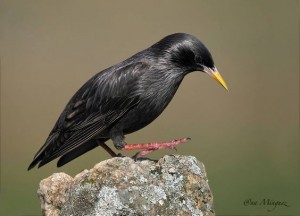One of the most wonderful things about the study of bird biology is the endless means by which birds of different species deal with the challenges of survival and reproduction. It will be immediately apparent to all that males of many bird species are brightly coloured, and have elaborate ornaments that presumably serve to attract females. Male birds also display a wide range of ritualized behaviours that allow a female to choose the best male from among potential suitors. What is less apparent is that female birds, seeking out the best males, also go to great lengths to impress.
In a recent publication, Juan Rubalcaba of the Universidad Rey Juan Carlos and his colleagues reported on their study of the behaviours of a bird species with complex nesting behaviour. The Spotless Starling has a large breeding distribution, ranging through Portugal, Spain and Italy, and across northwestern Africa. Its scientific name, Sturnus unicolor, is based on a couple of Latin words that translate to English as “the starling that is kind of boring to look at.” It does however, express some interesting behaviours at breeding time.
Rubalcaba and his team described Spotless Starlings as: “facultatively colonial and moderately polygynous.” Both males and females attempt to defend the territory against intrusion by members of their own sex. More is not better in this case. Males perform defense behaviours at the start of the breeding season, and collect leaves, flowers and lichen to the decorate the nest, attracting and stimulating potential mates. Later in the season, during egg-laying and incubation, females utilize feathers from other bird species to decorate the nest, presumably signaling her quality to her mate, and perhaps to dissuade other females from moving in.
Spotless Starlings utilize both natural cavities and artificial nest boxes. This gave the researchers the opportunity to establish high-density and low-density breeding areas within the study area. Do males occupying territories in high-density breeding areas bring more vegetation to the nest? Do females in high-density breeding areas bring more feathers to the nest?
In their study area near the community of Manzanares el Real in Central Spain, the researchers found that the answer to both questions was yes. More birds means more vegetation and more feathers. Furthermore, although the average number of eggs produced in the two areas was the same, the probability of nestling surviving long enough to leave the nest was lower in the high-density area. Greater competition resulted in lower reproductive success.
It seems that the use of plants and feathers as nest decorations by male and female Spotless Starlings signals of their territorial nature. The researcher explained that “The amount of green nesting material and feathers are related to the condition of males and females, respectively, and they may reflect their competitive abilities or willingness to defend their territories against conspecific competitors.”
It isn’t just males that need to impress. It seems that females can also benefit from the use of decorations to signal their status and health to other birds in the vicinity.
Rubalcaba, J. G., Daniel Fuentes, J. P. Veiga and V. Polo. 2017. Nest decoration as social signals by males and females: greenery and feathers in starling colonies. Behavioral Ecology 28:1369-1375.
Photo credits: www.flikr.com & www.pinterest.com



